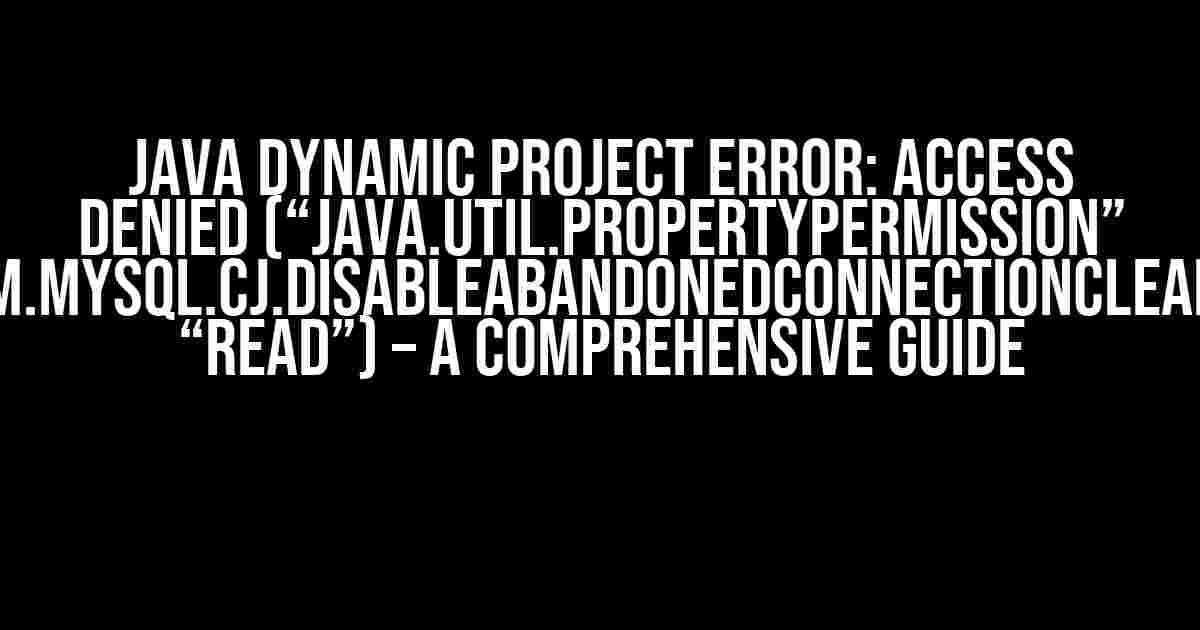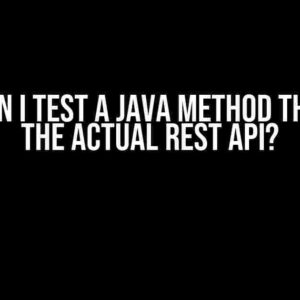Are you tired of stumbling upon the frustrating “java dynamic project error: access denied” error message when trying to connect to your MySQL database in a Java dynamic project? You’re not alone! This error can be a real showstopper, but fear not, dear developer, for we’re about to dive into the world of permissions and security policies to help you troubleshoot and resolve this issue once and for all.
What’s causing the error?
The error message “java dynamic project error: access denied (“java.util.PropertyPermission” “com.mysql.cj.disableAbandonedConnectionCleanup” “read”)” typically occurs when your Java application attempts to connect to a MySQL database using the Connector/J driver. The root cause of this error lies in the Java Security Manager, which is enabled by default in many Java environments.
Java Security Manager: The Culprit
The Java Security Manager is a mechanism that enforces a set of permissions and rules to ensure that Java code behaves securely. When the Security Manager is enabled, it restricts access to certain system resources, including properties and system variables. In this specific case, the error occurs because the Connector/J driver tries to read the “com.mysql.cj.disableAbandonedConnectionCleanup” property, which is denied by the Security Manager.
Resolving the Error: A Step-by-Step Guide
Don’t worry; resolving this error is relatively straightforward. Follow these steps to overcome the access denied issue:
Step 1: Disable the Java Security Manager
The simplest solution is to disable the Java Security Manager altogether. You can do this by adding the following parameter to your Java command:
-Djava.security.manager=falseThis will bypass the Security Manager’s restrictions, allowing your application to access the required properties. However, be aware that this approach may compromise the security of your application.
Step 2: Grant Permissions in the Java Policy File
A more secure approach is to grant the necessary permissions in the Java policy file. To do this, follow these steps:
- Create a new policy file (e.g.,
java.policy) with the following content:
grant {
permission java.util.PropertyPermission "com.mysql.cj.disableAbandonedConnectionCleanup", "read";
};- Specify the policy file when running your Java application:
java -Djava.security.policy=java.policy YourMainClass
This approach allows you to selectively grant permissions to specific properties, ensuring that your application remains secure.
Step 3: Configure the Connector/J Driver
Alternatively, you can configure the Connector/J driver to disable the abandoned connection cleanup mechanism. This approach eliminates the need to access the restricted property:
import java.sql.Connection;
import java.sql.DriverManager;
import java.util.Properties;
public class MySQLConnection {
public static void main(String[] args) {
Properties props = new Properties();
props.setProperty("com.mysql.cj.disableAbandonedConnectionCleanup", "true");
Connection conn = DriverManager.getConnection("jdbc:mysql://localhost:3306/your_database", "username", "password", props);
// ...
}
}By setting the “com.mysql.cj.disableAbandonedConnectionCleanup” property to “true”, you’re effectively disabling the abandoned connection cleanup mechanism, which no longer requires access to the restricted property.
Additional Troubleshooting Tips
If you’re still encountering issues, consider the following troubleshooting tips:
- Check your MySQL connection URL and credentials to ensure they’re correct.
- Verify that the Connector/J driver is correctly installed and configured.
- Review your Java application’s logging configuration to ensure that error messages are being properly captured and displayed.
- Consult the official MySQL Connector/J documentation for specific configuration options and troubleshooting guidelines.
Conclusion
The “java dynamic project error: access denied” error can be a frustrating obstacle, but by understanding the root cause and applying the solutions outlined above, you should be able to resolve the issue and successfully connect to your MySQL database. Remember to consider the security implications of each approach and choose the solution that best fits your application’s requirements.
| Solution | Description | Security Implications |
|---|---|---|
| Disable Java Security Manager | Bypasses Security Manager restrictions | High risk, compromises application security |
| Grant Permissions in Java Policy File | Grants selective permissions to specific properties | Low risk, ensures application security |
| Configure Connector/J Driver | Disables abandoned connection cleanup mechanism | Low risk, no security implications |
By following this comprehensive guide, you’ll be well on your way to resolving the “java dynamic project error: access denied” error and successfully connecting to your MySQL database.
Frequently Asked Question
Got stuck with the infamous “java.util.PropertyPermission” error while working on a Java dynamic project? Fear not, friend! We’ve got you covered with these 5 frequently asked questions and answers.
What is the “java.util.PropertyPermission” error, and why does it occur?
The “java.util.PropertyPermission” error occurs when your Java application tries to access a system property without the necessary permissions. This error often surfaces when you’re working with dynamic projects that involve database connections, like MySQL, and your Java application lacks the required permissions to read or write certain properties.
How is this error related to the com.mysql.cj.disableAbandonedConnectionCleanup property?
The com.mysql.cj.disableAbandonedConnectionCleanup property is a MySQL Connector/J property that controls the cleanup of abandoned connections. When your Java application tries to read or write this property, it requires permission to do so. If the necessary permissions are missing, the “java.util.PropertyPermission” error is thrown.
What is the purpose of the “com.mysql.cj.disableAbandonedConnectionCleanup” property?
The “com.mysql.cj.disableAbandonedConnectionCleanup” property is used to prevent the MySQL Connector/J from closing abandoned connections. When set to “true”, it allows the connection to remain open, even if the application doesn’t explicitly close it. This property is useful in scenarios where you want to avoid connection leaks or timeouts.
How can I fix the “java.util.PropertyPermission” error?
To fix the “java.util.PropertyPermission” error, you need to grant the necessary permissions to your Java application. You can do this by adding the required permissions to your Java policy file or by using the -Djava.security.policy command-line argument to specify a custom policy file.
Are there any alternative solutions to avoid this error?
Yes, there are alternative solutions to avoid the “java.util.PropertyPermission” error. One approach is to use a Java-based configuration mechanism, like Apache Commons Configuration, to manage your application’s properties. This way, you can avoid using system properties and the issues that come with them.


